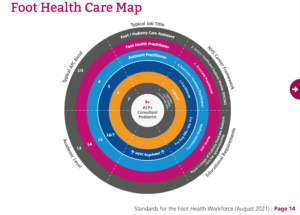Difficult decisions ahead
I have often travelled to those hallowed offices at the Society of Chiropodists & Podiatrists, The College of Podiatry and now the Royal College of Podiatry in South London. Before that, it was 53 Welbeck Street, North of the river. In all these journeys there was a common denominator, the underground PA system rattling out ‘Mind the Gap!’ I thought this a favourable title as indeed ‘that gap’ has a hidden concern lest we fall off the platform. For anyone wishing to check, the original voice belonged to sound engineer Peter Lodge and the message commenced in 1969 which was 6 years before I commenced my own Diploma in Podiatry (sic).

Has the College done a deal to change the membership, or is it a fact that there is little choice because of external factors? Next year will be a testing time for the Council of the Royal College of Podiatry. Is there a right or wrong decision, and can we learn from history? There again, by forgetting history, we make the same mistakes. Winter 2021 will be marked by the culmination of a change for the Royal College, and doubtless, elements of discussion will rumble on about how the membership is constituted. There are two groups separated by a divide – that gap! Separated by distrust, anger, betrayal and fear of one group while the other has diversified and no longer delivers what once was chiropody. What had caused such disparate behaviour?
Read the Editor’s review of the SAKS report
Does the SAKS Report finally reveal the truth?

The Royal College of Podiatry has recognised, not for the first time, that podiatry was shrinking due to the loss of members from both the independent and the NHS state sector. The recent pandemic had nothing to do with this attrition. More importantly, young undergraduate blood coming into podiatry was slipping due to factors that have been revealed [Whitham et al. 2021]. By the time Covid -19 had exacted its revenge on the health care professions, the independent sector, estimated to contain some 70% of the 12-13,000 podiatrists in practice, was not coping with patients [Report RCPod]. Many were turning patients away, and delays were exemplified alongside the dramatic changes in dentistry and general medical practice.
The deficit in foot health delivery concerned Health Education England (HEE) and led to the proposal to review the profession’s future. Groups such as the Institute of Chiropodists & Podiatrists (IOCP), OSGO, SMAE and Canonbury were involved with The Standards for the Foot Health Workforce in England consultations (September 2021). Chief Executive Steve Jamieson calls the development ‘a force for good’ and ‘strengthening ties and future-proofing our profession…’ (Nov/Dec The Podiatrist, Editorial 2021). Where once the Chair of Council was dominant in publicising change together with the CEO, Mr Jamieson has strengthened that voice and the face of the largest professional body representing podiatrists in the UK. The Royal College (RCP) realised that some integration with other groups could assist drive up standards by a period of investment and consolidation alongside the focus of how to increase the podiatric emphasis on foot health in the UK. In reality, the RCP had established the Foot Care Assistant as part of the workforce for many years. It was now considering an opportunity to envelope the Foot Health Practitioner (FHP).
The Foot Health Practitioner remains central to the argument
The FHP has no official registry in legislation compared to Chiropodist and Podiatrist which are protected titles under the National Health Service Reform and Health Care Professions Act 2002; and the HCPC will prosecute misuse of titles [HCPC]. Returning to the battle of wills; the podiatrist, and in particular the podiatrist retaining the dual-title chiropodist-podiatrist (Chir-Pod) with their cherished Diploma of Podiatric Medicine (DPodM), felt they were being sold out to a group who did not have the exceptional length of training over those educated by correspondence and limited face to face exposure to patients. The RCP is offering the opportunity for the FHP to have the type of benefits that many thought should be reserved for registered podiatrists. The proposals have been placed before the membership which in some quarters has been hostile doubtless leaving a mark at the recent Liverpool College November annual conference. There is a strong fact in life: mess with someone’s ability to earn, and all hell will unfold on the perceived antagonist. The Chir-Pod believed that by allowing FHP’s further support that they would continue to undercut them at every opportunity because the public would always go for the cheaper option. Of course, this is factually correct on the surface, but deep down, where lack of confidence arises, it is easy to see paranoia emerge. Good practitioners will keep their patients if this is the type of practice envisaged. If a service appears the same, the copied label will appear more attractive because the patient sees no difference in care. There will always be good and bad podiatrists, as there will be with the FHP or General practitioner of medicine. Not all FHPs are bad, and many have transferred from other health professionals, notable nursing and health care.
Apprentice scheme options
Jennifer approached me to discuss her potential entry into podiatry. The upshot was my efforts to guide her toward the apprenticeship scheme fell short because she would not achieve an agreed release to make this work financially. Again, there were reasons of a personal nature. With a baby on the horizon she had to work out how to make a living if she was to turn her back on her NHS income. There was only one conceivable route, and that was FHP. She could train at a low cost, start to earn and then, in time, consider if she could upgrade. Jennifer is one example of a mature student making decisions based on financial reality. She had the academic skills and could bring her specialism to a profession willing to welcome her. But, there we were over our coffee cups, each faced with the reality of life. I could not blame her and gave her one of my recent books, ‘Foot Health Facts Myths and Fables’, that I hoped would allow her to reflect on a different path. After all, there would be many months before she could make the change with a new family member.
Diversity in podiatry is a fact of life
The podiatry profession is made up of graduates from schools, those who may have already had a formal career like Jennifer, or those who just want to return to higher education having had a family. Everyone has a right to do what they want or feel able to do. However, the RCP has to ensure the viability of the future, and given the dwindling workforce, it is faced with two prospects. Continue with an ageing membership and hope for the best, or be proactive. Change is often painful because not everyone benefits. I would like to provide some back history which will show my age but should open those reader eyes to a different perspective.
Missed opportunity
In the early 1980s, a BBC regional news programme called Nationwide featured people conducting verruca treatment without having a formal registration with the then Council for the Professions Supplementary to Medicine (CPSM). The CPSM was the forerunner to the HCPC (2003). The claim was that people were passing themselves off as chiropodists and doing harm because their inferior training led to damage that was negligent. There was no substantiated evidence to make such a case. The so-called State Registered Chiropodist could not show sufficient reason to make this high risk or a substantial reason for legislative change. Hopes for closure would wait another 23 years! When closure arrived , it would be indicative (title) rather than functional (action); another blow to the profession. However the educational name chiropody was unwisely retained. The DPodM award allowed everyone to convert to ‘podiatrist’ included for the newer degree graduates, and those completing the older diplomate course. Therefore, the HCPC retained both chiropodist and podiatrist on its register.
Unsavoury images of practice
During the height of the pandemic, Amanda Garner, an FHP, was treating a patient in what appeared bizarre circumstances as her patient and she were attempting to provide a safe environment. The patient and FHP were outside with a makeshift screen across the threshold of the patient’s front door, [BBC South West]. The patient had her legs poking out while Ms Garner appeared in full PPE, an image likened to a miner about to travel down a coal mine; and yet the FHP was delivering a worthy service. She informed the BBC regional programme of her correct title, but the journalist failed to recognise the difference between her activities and podiatrists. Facebook lit up with many different viewpoints; some sadly downright unkind, rude, unprofessional and unsympathetic. If someone reflects an unsavoury image, then it is felt more keenly on those who follow similar practice, but, she was offering a much needed service. Unfortunately, it was but an image and this would not have troubled most podiatrists.
History repeats itself
The Society of Chiropodists and forerunner to the Royal College of Podiatry were opposed as an organisation in 1978-9 to the development of FCAs because of the fear of taking the role of then Chiropodists and diluting the profession. Having been part of FCA education at the same time as a young professional I was able to observe the different attitudes between the Chief Chiropody Officers (ACCO) and the Society of Chiropodists. In 2021 I wrote’ “The issue over Foot Care Assistants (FCAs) raged for a while. These were people Luuk (pseudonym) wanted to train to undertake nail care. Today this is no longer the problem it once was. The Royal College of Podiatry includes FCAs within the organisation with its own core curriculum. The old Society’s fears were never realised and it is my view that Luuk’s efforts supported by Kirstin (pseudonym) and other Northampton sector chiropodists were correct.” [i]
By 1993 the podiatry profession had been in a state of civil war. Managers under the Association of Chief Chiropody Officers (ACCO) had fallen out with the Society of Chiropodists (SCP), and all had fallen out with the Podiatry Association (PA) – the former group spearheading podiatric surgery. Then, along came the Royal College of Surgeons with a new review (Commission on Provision of Surgical Services 1995); partnered by the Podiatry Asssociation (PA). “The COPPS report was set up by by the PA board and 2 Vice Presidents of the RCS who believed a way for co-operation could be found.” [7]. Without boring the reader further, there was a golden opportunity to merge in some shape and form with the Royal College and its orthopaedic wing, the British Orthopaedic Association. The disagreement led to the emergence of what became the College of Podiatry in 1996-7, the Faculties formed after the fallout with the orthopaedic fraternity who had missed their opportunity to control podiatric surgery. They failed to desire welcoming the podiatric surgeons and others into the College. The CoPPS report was duly buried, unavailable in the internet although a few of us refused to throw our copies away.
As much as anyone, the podiatric surgeons had created the disharmony through a natural desired progress to take podiatry to new heights. The orthopaedic surgeons were as concerned about the lower grade training of the podiatrist in the arena of surgery as the podiatrist today views the Foot Health Practitioner. In fact, in those early days, many chiropodists, now enjoying a common title, were not happy with the podiatric surgeons who also brought unwanted publicity to their doorstep. Annotation through the HCPC in January 2022 is fully integrated with an upgraded education, and we now see many of those old enmities fading. Podiatric surgery offers one way of supporting and acting as a conduit for advanced practice for all podiatrists. As one group has reached the end of the beginning, so to speak, another opportunity opens. By providing a home for the FHP, a new era commences. One to help one group develop better education and maybe a role within the NHS at a commensurate Agenda for Change grade (AFC). This type of process could have been available through the Royal College had the BOA not kicked up and threatened resignation[ii].The spinning wheel associated with relative AFC grades that looks like a dartboard seems confusing, but it is an attempt to offer integration.

What to do with those at the lower end of the practice spectrum?
No one should be penalised or suffer the demise of their role. On the contrary, because podiatrists enjoy a comfortable practice, visiting and delivering good care, their work should be respected. Furthermore, their training would have been far above those who had trained before the original three-year course leading to the Diploma.
Salutary memories
In 2012 the College of podiatry through the Council of Chiropodists & Podiatrists exerted a brutal imposition on the podiatric surgeons. Because of the risk imposed by their practice, PSs would have to stump up the larger share for their indemnification. Fees at the time cost circa £350 for membership of Fellows in surgery which included indemnification and paid uniformly by everyone. However, insurance premiums were escalating for all members, and it was simply wrong for PSs to sit on the coattails of such a low membership fee. The imposition came almost without warning, and suddenly PS’s who did little surgery or undertook such procedures infrequently were hammered, placing part of their livelihood at risk. It might surprise many that the hike was near 20x the previous fee. The outcome; between 5-10% (estimated) of the PSs lost their vocational preference.
Was this right, and did this make the new College the beast incarnate? As Dean of the Faculty at the time, I was shocked, as we had no time to prepare our members or take steps for a plan B. It was right that PSs paid higher fees, not least as their earnings were exponentially higher than many podiatrists. Those in the NHS were better protected, and some decided that private practice was no longer viable. Not an ideal plan B maybe, but there was a silver lining and one that proved wise, if not intended, let alone palatable. To lose a group of professionals with skills was one thing; to enhance quality and standards was a different moral argument than preserving salaries alone.
This change became important in order for the Faculty of Surgery to progress, leaving those who practised surgery at a full-time level as their chosen extended scope. Those podiatrists who do not wish to develop further are at liberty to practice as an FHP. The RCP will not penalise them, although they will have to pay the price again as those who failed to practice to the full extent as surgeons. No organisation can guess what level of indemnity is needed with so many outlets, but indemnification has to be set at a commensurate level of standard podiatry practice. That practice is no longer set at what one might call basic level care. Having a Diploma or degree matters little if you practice as an FHP. The reality comes home when we read a message from one podiatrist.
“I am a mobile podiatrist and am wondering if there is a cheaper insurance option to the RCP. I am thinking of giving up my HCPC registration in time, as I honestly don’t think it is worth it. As a mobile pod, I generally deal with very routine treatments. Probably similar to an FHP. Does anyone have advice on this?…” Anon Nov. 2021
Clear membership divisions are required
Painful changes must be made for a profession to thrive, succeed and exceed. Nonetheless the RCP should follow some of the processes used by IOCP and SMAE when engaging with different membership levels. Misuse of the badge and brand of the Royal College should be considered seriously. In all other respects the deal is done whether intended or not as it is now out the hands of the Royal College to stop attrition but in the hands of members to arrest the rot that has blighted podiatry for so long. Podiatry is a medical based science career. Foot Health Practitioners are an important part of palliative care; the two can work together.
![]()
- Whitham, D., Whitham, S., Trowell, M. et al. Podiatry as a career in the UK – what attracts Generation Z? A qualitative exploration with university and college students. J Foot Ankle Res 14, 33 (2021). https://doi.org/10.1186/s13047-021-00470-y
- SAKS Report Accessed 3/12/21 https://rcpod.org.uk/news/royal-college-of-podiatry-publishes-landmark-saks-report
- HCPC Prosecution Policy accessed 3/12/21 https://www.hcpc-uk.org/globalassets/resources/policy/prosecution-policy-protection-of-title.pdf?v=637117400980000000
- Apprenticeship scheme (Plymouth University) accessed 3/12/21 https://www.plymouth.ac.uk/study/apprenticeships/podiatry-degree-apprenticeship
- BBC South West Report (Cornwall) accessed 3/12/21 https://www.bbc.co.uk/news/uk-england-cornwall-56022563
- Commission on the Provision of Surgical Services 1995 Published by the Podiatry Association. The link takes you to the title and evidence of publication but no content has been retained. The Editor (DT) retains a copy in his library. The membership of the Podiatry Association amalgamated with the Society of Chiropodists and Podiatrists in 1996 but the original Podiatry Association Ltd title was owned and registered by the Society of Chiropodists who did not at that time use the official title podiatry or podiatrist. Podiatrist was a title only available to those taking the first part of the fellowship examination (MPodA).
- Graham, Ralph B Personal correspondence Dec. 2021
[i] Foot care assistants. Tollafield DR. 2021 This was taken from Podiatrist on a Mission as postscripted notes p.307. Published by Busypencilcase Communications and available from Amazon books
[ii] Turbutt Ian, former Chair of the Podiatry Association and Podiatric Surgeon. Personal communication 2021
Other articles in the series about the changing landscape, delivery of footcare and the profession of podiatry
- Does the Ugh Factor affect Podiatry Recruitment?
- What’s the difference between chiropody & podiatry?
- Who is behind the SAKS report on Podiatry?
- Does the SAKS report finally reveal the truth?
Thanks for reading ‘Mind the Gap’ by David R Tollafield

Published by Busypencilcase Communications Est. 2015
13th December 2021


Recent Comments